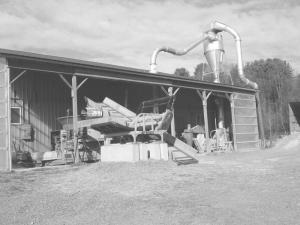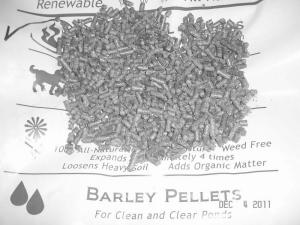On-Farm Pellet Business Turns Weeds Into Cash
You can turn weedy hayfields into cash with pellet-making equipment. Rob and May Miller, son Mike and his wife Marylou are doing just that in upstate N.Y. The former dairy farmers are direct marketing pellets of weeds, grass and hay for fuel, mulch and soil additives, as well as for cat litter and pet bedding. When not pelleting waste forage, they also pelletize barley straw to clean up farm ponds, wood for fuel and kiln-dried pine for horse bedding.
“We started out making our Enviro Energy pellets from poor quality hay and weeds for use in pellet stoves,” says Mike Miller. “We’ve expanded markets for the pellets as we find new products to market.”
Raw material comes from area fields that are no longer actively farmed, or hay spoiled by rain. Old hay and crop fields grow up with weeds and grass. Left too long, they fill in with brush and trees.
Btu-wise, the pellets are similar to wood pellets, with 17 lbs. of pellets equal to about a gallon of fuel oil. However, some older pellet stoves can’t handle the higher ash content. Newer stoves are better designed to handle the ash. As a result it has taken longer than expected to build a market for the grass fuel pellets.
Meanwhile, the Millers developed a secondary market for the grass pellets as mulch and soil additives. A single layer of pellets on the ground expands 5 to 6 times as they absorb water, producing several inches of weed-stopping mulch. The pelleting process destroys any seeds, so the mulch itself is weed seed-free.
The following season, the mulch can be dug into the soil where it loosens up hard clay and retains water in sandy soils. The pellets also add nutrients.
The pellets, which sell for $4.50 per 40-lb. bag, can also be added directly to soil in gardens, in the field or even in pots for houseplants. “They practically explode in the ground as they absorb moisture,” says Miller.
The Millers have developed a special low heat pelleting process to make soft grass pellets for the cat litter and pet bedding market. They also make pellet barley straw. Using barley straw to control algae growth in ponds is a well-established practice. Barley straw pellets are easier to handle and more effective than straw.
The Millers use an electric-powered, 2 ton per hour Sprout Waldren pelletizer. Different materials require different pelleting dies, which the Millers have custom made. Changing products requires little more than switching a die.
“Currently I am consulting with the University of Maine and a guy from Vermont who wants to pelletize switchgrass and Reed canarygrass,” says Miller. “I’m available to work with others who want to set up a business like ours.”
Contact: FARM SHOW Followup, Enviro Energy, LLC, 2265 State Highway 7, Unadilla, N.Y. 13849 (ph 607 988-9013; www.enviroenergyny.com).

Click here to download page story appeared in.
On-Farm Pellet Business Turns Weeds Into Cash CROPS You can turn weedy hayfields into cash with pellet-making equipment Rob and May Miller son Mike and his wife Marylou are doing just that in upstate N Y The former dairy farmers are direct marketing pellets of weeds grass and hay for fuel mulch and soil additives as well as for cat litter and pet bedding When not pelleting waste forage they also pelletize barley straw to clean up farm ponds wood for fuel and kiln-dried pine for horse bedding “We started out making our Enviro Energy pellets from poor quality hay and weeds for use in pellet stoves ” says Mike Miller “We’ve expanded markets for the pellets as we find new products to market ” Raw material comes from area fields that are no longer actively farmed or hay spoiled by rain Old hay and crop fields grow up with weeds and grass Left too long they fill in with brush and trees Btu-wise the pellets are similar to wood pellets with 17 lbs of pellets equal to about a gallon of fuel oil However some older pellet stoves can’t handle the higher ash content Newer stoves are better designed to handle the ash As a result it has taken longer than expected to build a market for the grass fuel pellets Meanwhile the Millers developed a secondary market for the grass pellets as mulch and soil additives A single layer of pellets on the ground expands 5 to 6 times as they absorb water producing several inches of weed-stopping mulch The pelleting process destroys any seeds so the mulch itself is weed seed-free The following season the mulch can be dug into the soil where it loosens up hard clay and retains water in sandy soils The pellets also add nutrients The pellets which sell for $4 50 per 40-lb bag can also be added directly to soil in gardens in the field or even in pots for houseplants “They practically explode in the ground as they absorb moisture ” says Miller The Millers have developed a special low heat pelleting process to make soft grass pellets for the cat litter and pet bedding market They also make pellet barley straw Using barley straw to control algae growth in ponds is a well-established practice Barley straw pellets are easier to handle and more effective than straw The Millers use an electric-powered 2 ton per hour Sprout Waldren pelletizer Different materials require different pelleting dies which the Millers have custom made Changing products requires little more than switching a die “Currently I am consulting with the University of Maine and a guy from Vermont who wants to pelletize switchgrass and Reed canarygrass ” says Miller “I’m available to work with others who want to set up a business like ours ” Contact: FARM SHOW Followup Enviro Energy LLC 2265 State Highway 7 Unadilla N Y 13849 ph 607 988-9013; www enviroenergyny com
To read the rest of this story, download this issue below or click
here to register with your account number.







